


ChessBase 17 - Mega package - Edition 2024
It is the program of choice for anyone who loves the game and wants to know more about it. Start your personal success story with ChessBase and enjoy the game even more.

Round 7: Sunday, February 25th |
||
| Peter Leko |
0-1 |
Vishy Anand |
Vassily Ivanchuk |
1-0 |
Levon Aronian |
Veselin Topalov |
1-0 |
Alex. Morozevich |
Peter Svidler |
½-½ |
Magnus Carlsen |

After this round the tournemant continues in Linares, Spain, starting on March 2nd.and ending on March 10. Tomorrow, Monday February 26 is transfer day. All players, their seconds, wives, companions, distant acquaintances, the Spanish staff, the journalists, everyone vaguely connected with the tournament, have been instructed to be outside the Los Juaninos Hotel, where most of the players are staying, at 9:30 sharp, to board a bus which will take us to Mexico City airport. There, after waiting for about five hours, we will, all of us, board a Aero Mexico flight at 18:35h to arrive in Madrid: the next day at noon (local time). From there most of the players will proceed to Linares and sleep for 26 hours. By March 2nd they will hopefully have reset their internal clocks and be ready to play again.
We of the ChessBase team will also be out of commission for the same period of time – until Tuesday evening European Time. That is when we will resume our reporting. We hope our readers will bear with us and not suffer too harshly from this 28-hour news blackout. How about a nice book, or a picnic with the family, to bridge the time. We will return to reporting on the Morelia-Linares event, with a number of still-to-be-told excursion stories, as soon as possible.
The following express commentary was provided by Romanian GM Mihail Marin, who is the author of a number of very popular ChessBase training CDs and articles for ChessBase Magazine. GM Marin will study the games of the Morelia/Linares tournament in greater detail and provide the full results of his analysis in the next issue of ChessBase Magazine.
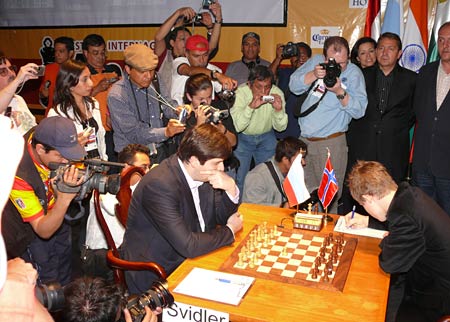
Photographes going nuts over Svidler vs Carlsen
Svidler,P (2728) - Carlsen,M (2690) [B35]
XXIV SuperGM Morelia/Linares MEX/ESP (7), 25.02.2007 [Mihail Marin]
1.e4 c5 2.Nf3 Nc6 3.Nc3 g6 4.d4 cxd4 5.Nxd4 Bg7 6.Be3 Nf6 7.Bc4 0-0 8.Bb3


18...f6! Optically speaking, an "ugly" move, creating a weakness and restricting the own bishop. However, this is the lesser evil in this position. Allowing the exchange of the dark-squared bishops would have left Black's position in ruins. 19.Rxe8+ Qxe8 20.h3 Qf7 21.Nb4 Bf8 22.Nxc6 bxc6 23.b4 Bd6 24.b5 cxb5 25.Bxf6 a5 26.Bd4 Qf4 27.Qxf4 1/2-1/2. [Click to replay]
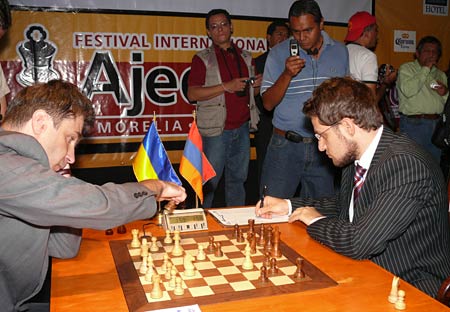
Somewhat less attention given to Ivanchuk vs Aronian
Ivanchuk,V (2750) - Aronian,L (2744) [D38]
XXIV SuperGM Morelia/Linares MEX/ESP (7), 25.02.2007 [Mihail Marin]
1.d4 Nf6 2.c4 e6 3.Nf3 d5 4.Nc3 Bb4 5.Bg5 Nbd7. In spite of the dangers
he had passed through in his earlier game against Morozevich, Aronian did not
lose faith in this variation. 6.cxd5 exd5 7.Qc2 Ivanchuk chooses a quiet
system of development, which is not without poison as we shall see. 7...c5
8.a3 Bxc3+ 9.Qxc3 h6 10.Bxf6. Consequent to his linear strategy. 10.Qe3+
was played in Van Wely-Sargissian, Bundesliga 2006 and Van Wely-Aronian, Wijk
aan Zee 2007, which might be a hint that this line is an Armenian specialty.
10...Qxf6 11.e3 0-0 12.Be2 b6 13.0-0 Bb7.
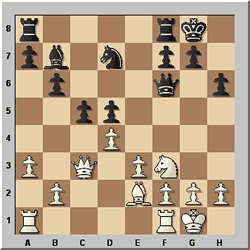
The position is characteristic for the Tartakower-Makagonov-Bondarevsky variation of the Queen's Gambit declined. The main differences are that in the QGD the queens find themselves in opposition on the a3-e7 diagonal and that the black bishop is developed slightly more actively on e6. 14.Rfc1. A novelty. White usually developes the other rook on c1. 14...Rac8 15.dxc5 Qxc3 16.Rxc3 Rxc5. Black cannot maintain the compactness of his structure with 16...bxc5 because of 17.b4 , ensuring White the control of the d4-square. The point behind Ivanchuk's novelty is revealed after 17...cxb4 18.Rxc8 Rxc8 19.axb4 when the queen's rook is optimally placed on its initial square. 17.Rcc1!? A paradoxical move. White is not sufficiently well prepared to fight for the control of the c-file with 17.Rac1 because of 17...Rfc8 when 18.Rxc5 bxc5 19.b4 cxb4 leads to simplification and a probable draw, in spite of Black's isolated pawn. One general rule states that the side playing against the isolani should keep as many major pieces on board and try to provoke the exchange of minor pieces, in order to successfully attack the relative weakness of the central pawn. From this perspective, Ivanchuk's willing retreat is easy to understand. 17...Rfc8?! Obviously missing White's idea. Safer would have been 17...Rxc1+ 18.Rxc1 Rc8. 18.Rd1! Of course. Black's activity along the c-file will have a temporary character, while the pressure against the d5-pawn will be permanent. 18...Rc2 19.Bb5 Nf8 20.Rab1 R2c7 21.Ba4 Ne6 22.Bb3 Kf8 23.h3 Rc5 24.Kh2 Ke7 25.Rd2 Rb5 26.Ba2 Rbc5 27.Ne1 a5 28.Rbd1 Rd8 29.Kg3 Rb5 30.f3.

White has a pleasant position, but there is a long way till achieving something more concrete still. 30...Rc8? Rather careless. Black should have brought the other rook into safety with 30...Rc5. 31.Nd3! Suddenly, the rook is trapped. The threat a4 is hard to prevent in adequate way. 31...d4. Other moves also lose this pawn, for instance 31...a4 32.Nb4 Nc7 33.e4 when 33...dxe4 34.Rd7+ leads to a devastating attack; or 31...Nc5 32.Nf4 Na4 33.Bxd5 Bxd5 34.Nxd5+ when the central knight compensates for the presure against the b2-pawn. 32.Bxe6 Kxe6 33.Nf4+ Ke7 34.Rxd4 Rc7 35.R1d2.

White is basically winning now, but Aronian went down rather quickly, possibly demoralized by the unexpected course of events. 35...Rbc5 36.e4 Rc4 37.Rd6 R4c6 38.e5 Rc2 39.Rxc2 Rxc2 40.Rxb6 Bc6 41.b4 g5 42.Nh5 axb4 43.axb4 Bd5 44.Ng7 Re2 45.Nf5+ Ke8 46.Nxh6 Be6 47.Rb5 Rb2 48.Rb8+ Kd7 49.Rg8 1-0. [Click to replay]

No handshake or eye contact accorded to Topalov (seft) by Morozevich
Topalov,V (2783) - Morozevich,A (2741) [C11]
XXIV SuperGM Morelia/Linares MEX/ESP (7), 25.02.2007 [Mihail Marin]
1.e4 e6 2.d4 d5 3.Nc3 Nf6 4.e5 Nfd7 5.f4 c5 6.Nf3 Nc6 7.Be3 a6 8.Ne2.
A rare move, aimed to consolidate the d4-square at the cost of delaying the
development of the queenside The normal continuation is. 8.Qd2 . I would quote
here a recent example form the practice of another great French expert, which
bears some similarity with our main game: 8...b5 9.a3 g5!? and Black managed
to undermine White's centre, although the position remained complicated, Jakovenko-Bareev,
Sochi 2006. 8...Qb6 9.Qc1.


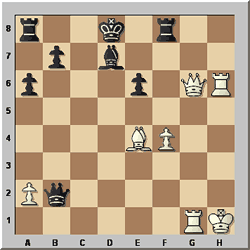
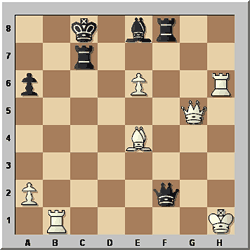
White is a pawn up and his king is in absolute safety. The long diagonal, the h-file and the back rank are well defended. The black king is under no immediate threat, but one can smell the danger approcahing. 42...Qd4. It is too late now for 42...Qf4 because of 43.Qxf4 Rxf4 44.Rh8 Re7 45.Bg6 , winning the bishop. 43.Bg2 Rf4 44.e7 Rc5 45.Qg3 Rc3 46.Qe1 Re3 47.Qa5 Bb5 48.Rc1+ 1-0. [Click to replay]

Peter Leko vs Vishy Anand – the two are friends and have
worked together
Leko,P (2749) - Anand,V (2779) [E04]
XXIV SuperGM Morelia/Linares MEX/ESP (7), 25.02.2007 [Mihail Marin]
1.d4 Nf6 2.c4 e6 3.g3 d5 4.Nf3 dxc4 5.Bg2 a6 6.0-0 Nc6 7.e3 Bd7 8.Nc3.

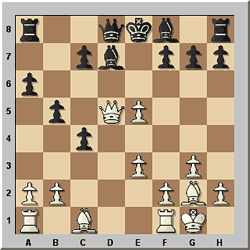

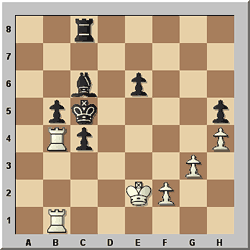
White's resignationmight look a bit premature, but in fact there is nothing he can do against the enemy pawns supported by all Black's pieces. 0-1. [Click to replay]

A view from the top: the Theatre in Morelia with the games in progress
|
|
||||||||||||||||||||||||||||||||||||
|
|||||||||||||||||||||||||||||||||||||
|
|
||||||||||||||||||||||||||||||||||||
|
|||||||||||||||||||||||||||||||||||||
|
|||||||||||||||||||||||||||||||||||||